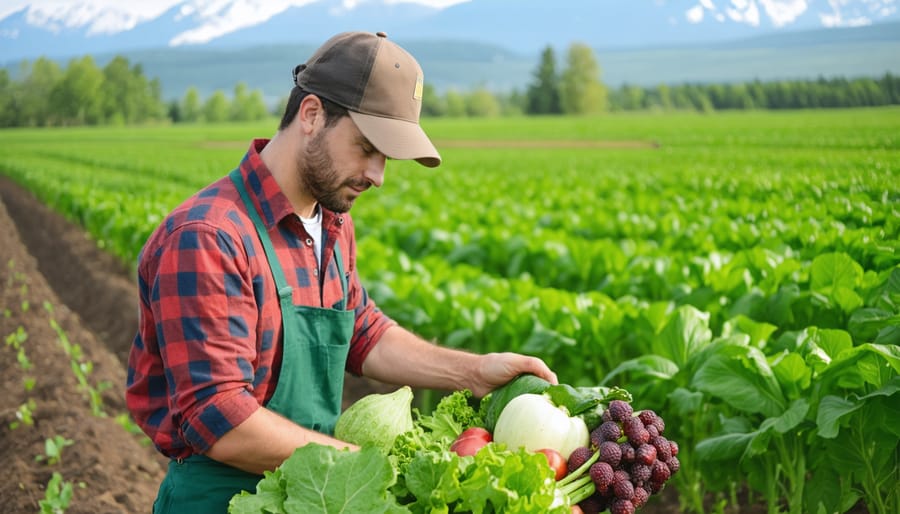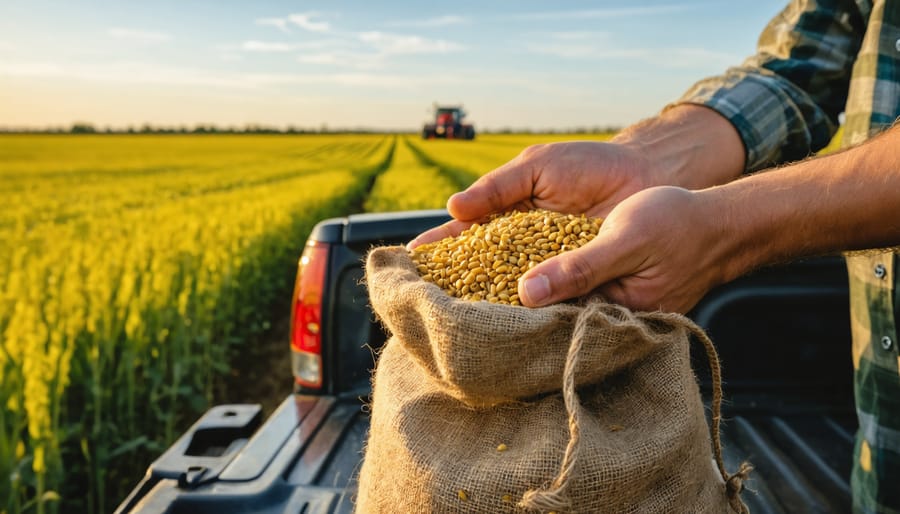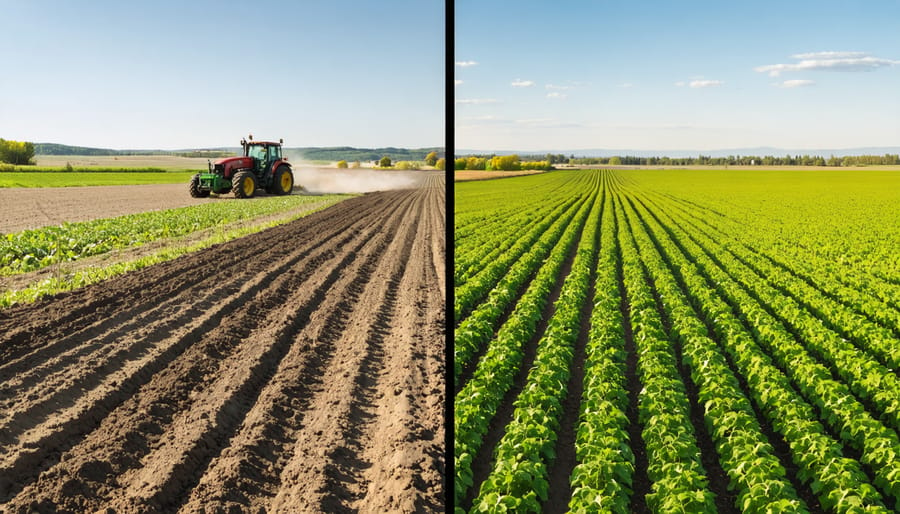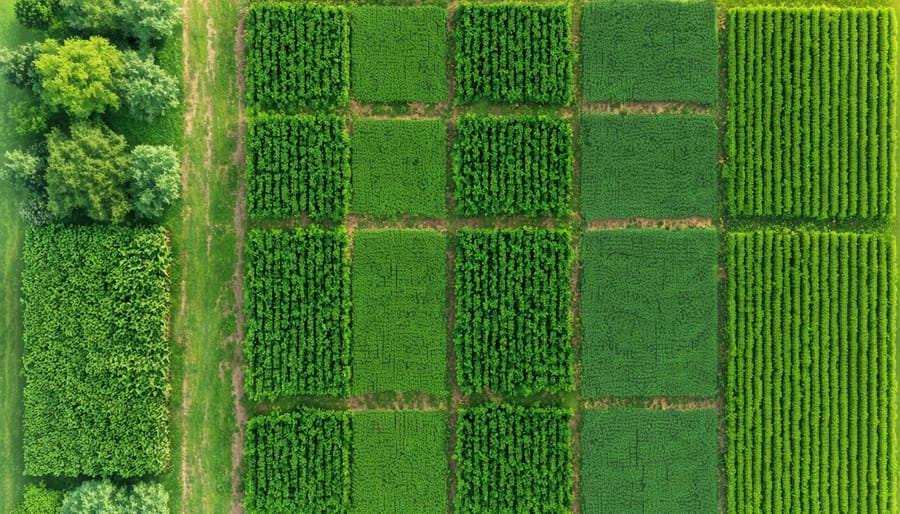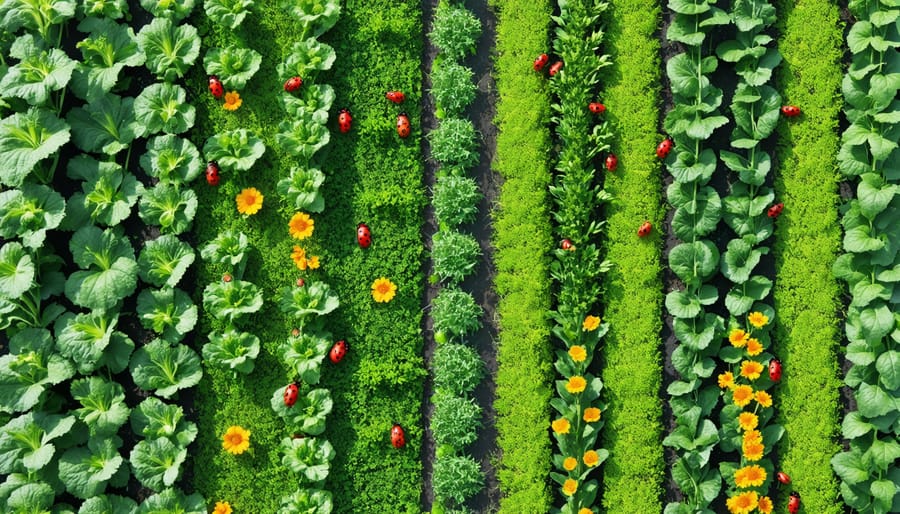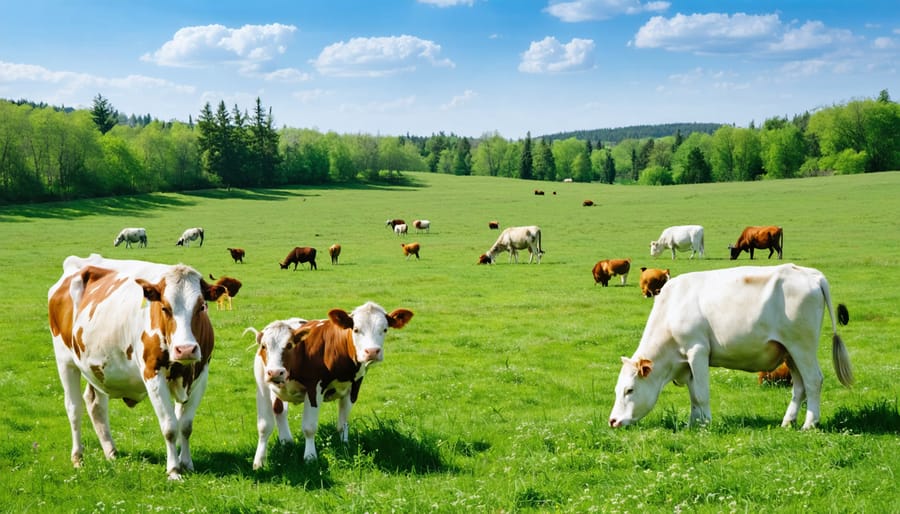Transform your farm into a certified USDA organic operation through a systematic organic certification process that starts with three years of documented chemical-free cultivation. Document every aspect of your agricultural practices, from seed sources to soil management strategies, using detailed record-keeping systems that meet USDA’s strict verification requirements. Implement a comprehensive Organic System Plan (OSP) outlining your farm’s specific methods for maintaining soil fertility, managing pests naturally, and preventing contamination from prohibited substances. Canadian producers must align their practices with both USDA organic standards and the Canadian Organic Regime (COR) requirements when targeting cross-border markets, ensuring compliance through recognized certification bodies operating in Alberta. The investment ranges from $1,200 to $3,500 annually for most small to medium-sized operations, with costs varying based on acreage, crop diversity, and certification body selection. This certification opens access to premium markets while contributing to sustainable agriculture practices that resonate with today’s environmentally conscious consumers.
Core USDA Organic Requirements for Small Farms
Land Management Standards
One of the foundational requirements for USDA organic certification is the three-year transition period for land management. During this time, your fields must be completely free from prohibited substances, including synthetic fertilizers, pesticides, and genetically modified organisms (GMOs). This transition period ensures that soil and surrounding ecosystems have sufficient time to recover and establish natural biological processes.
Here in Alberta, many farmers have successfully navigated this transition by implementing cover cropping and crop rotation strategies. For example, the Peterson family farm in Red Deer County maintained soil fertility during their transition period by rotating alfalfa, field peas, and wheat while gradually building organic matter.
All land parcels must have distinct, defined boundaries and buffer zones to prevent contamination from adjacent conventional farming operations. These buffer zones typically range from 8 to 30 metres wide, depending on your specific situation and surrounding land use.
Detailed records of land management practices are essential during the transition period. You’ll need to document all inputs, activities, and monitoring procedures. Many Alberta farmers find success using digital record-keeping systems that track field histories, crop rotations, and input applications.
Remember that soil building and natural pest management strategies should be implemented well before the transition period begins to ensure a smooth shift to organic production methods.
Soil and Water Conservation Practices
Under USDA organic certification, farmers must implement comprehensive soil and water conservation practices that protect and enhance natural resources. These practices start with regular soil testing methods to monitor nutrient levels and organic matter content.
Key soil conservation requirements include implementing crop rotations, using cover crops, and maintaining vegetative buffer zones. Prairie farmers in Alberta have found success with diverse rotation patterns that include nitrogen-fixing legumes like field peas and alfalfa. Tillage practices must minimize soil erosion, with many producers adopting reduced-till or no-till methods where feasible.
Water conservation and quality protection are equally important. Producers must maintain riparian areas along waterways and implement practices that prevent soil erosion and runoff. This includes establishing grassed waterways, contour farming on slopes, and using appropriate irrigation scheduling to prevent water waste.
Organic producers must also maintain detailed records of their conservation practices, including maps of buffer zones, documentation of rotation schedules, and water management plans. Many Alberta farmers have found success using digital record-keeping systems that track these requirements while helping optimize resource use throughout the growing season.
These practices not only meet certification requirements but also build long-term soil health and water security for sustainable farm operations.
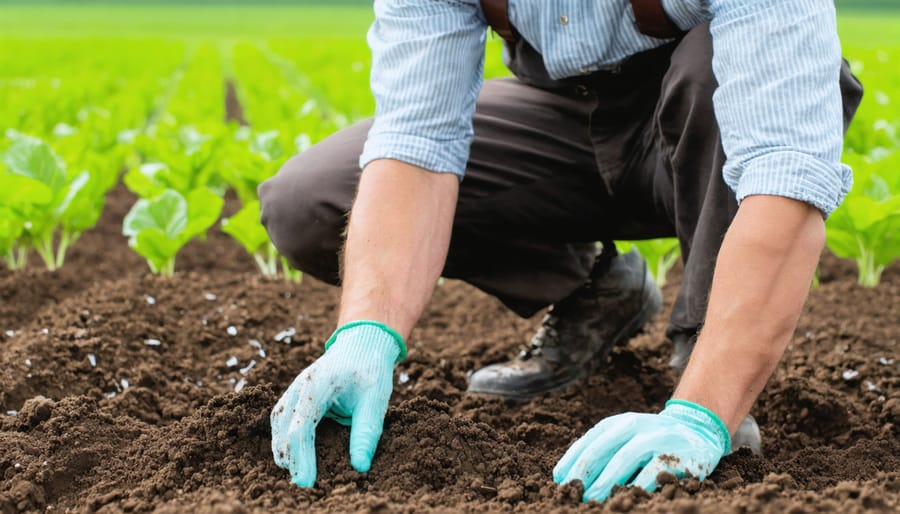
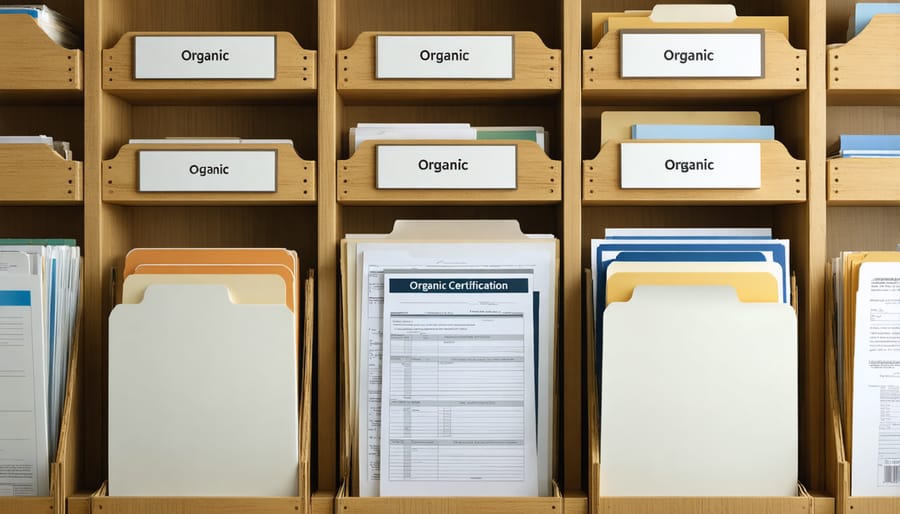
Documentation and Record-Keeping
Organic System Plan (OSP)
The Organic System Plan (OSP) is your farm’s roadmap to organic certification and serves as a living document detailing your operation’s practices. As an Alberta farmer pursuing USDA organic certification, you’ll need to outline your production methods, including crop rotation plans, soil management strategies, and pest control measures.
Your OSP should comprehensively document input materials, record-keeping systems, and measures to prevent contamination from conventional farming practices. Keep in mind that many successful organic farms in Alberta maintain detailed records of seed sources, crop locations, and harvest dates as part of their OSP.
When developing your plan, focus on these key areas: soil fertility management, crop rotation schedules, pest and weed control methods, and handling procedures. Include specific details about buffer zones between organic and conventional fields, which is particularly important in our prairie landscape where neighbouring farms may use conventional methods.
Local organic farmer Sarah Thompson from Red Deer shares, “Creating my OSP seemed overwhelming at first, but breaking it down into manageable sections made it achievable. I update it regularly as my operation evolves.”
Remember that your certifying agent will review your OSP annually, so maintain clear, organized records and be prepared to adjust your plan as needed. Consider working with experienced organic farmers in your area who can provide valuable insights based on their certification journey.
Input and Production Records
Maintaining detailed records is a cornerstone of USDA organic certification. As an Alberta farmer, you’ll need to document every aspect of your farming operation, from seed purchases to harvest yields. Start by creating a materials log that tracks all inputs, including seeds, fertilizers, and pest control substances. Each entry should include the date of purchase, source, and organic certification status.
Keep comprehensive field records documenting your farming practices, including planting dates, crop rotation schedules, and soil management activities. For example, if you’re growing organic wheat near Lethbridge, record details about cover cropping, tillage methods, and natural pest management strategies.
Harvest records are equally crucial. Document yields, storage locations, and cleaning protocols for equipment. Many Alberta farmers find success using digital record-keeping systems, though paper records are acceptable if well-organized. Include sales receipts, shipping records, and organic certificates from suppliers.
Consider creating a standardized template for daily activities. Local organic farming groups often share effective record-keeping systems. Remember to maintain these records for at least five years, as required by certification bodies. Regular updates and consistent documentation make annual inspections smoother and help demonstrate your commitment to organic integrity.
Cost Considerations and Support Programs
Certification Cost Structure
The cost of USDA organic certification typically involves several components that Canadian farmers should budget for carefully. Initial certification fees generally range from $1,200 to $3,500 CAD, depending on your farm’s size and complexity. Annual renewal fees usually fall between $900 and $2,500 CAD.
Assessment fees are calculated based on your operation’s gross annual organic sales, typically ranging from 0.1% to 0.5% of organic revenue. For Alberta farmers, many certification bodies offer sliding scale fees to support smaller operations getting started.
Additional costs to consider include inspection fees ($400-800 CAD per visit), soil testing ($150-300 CAD per sample), and administrative expenses for record-keeping systems. Many Canadian farmers find it helpful to budget approximately $2,500-4,000 CAD for their first year of certification, with costs typically decreasing in subsequent years.
The good news is that the Canadian Organic Farming Cost-Share Program offers reimbursement of up to 75% of certification costs for eligible farmers, making the transition more financially accessible. Be sure to maintain detailed records of all certification-related expenses for reimbursement applications and tax purposes.
Financial Assistance Options
Canadian farmers pursuing USDA organic certification can access several financial assistance programs to help offset certification costs. The USDA Organic Certification Cost Share Program (OCCSP) offers reimbursement of up to 75% of certification costs, with a maximum of $750 per certification scope annually. Alberta producers can also benefit from provincial programs like the Canadian Agricultural Partnership (CAP), which provides additional support for organic transition and certification.
Local agricultural societies and organic farming associations often offer matching grants and mentorship opportunities. The Organic Federation of Canada maintains partnerships with credit unions and agricultural lenders who provide specialized financing options for organic certification expenses. First-time applicants should note that many of these programs operate on a first-come, first-served basis, so early application is recommended.
To maximize available support, farmers are encouraged to maintain detailed records of all certification-related expenses and connect with their local organic farming associations for guidance on accessing these resources. Remember to check application deadlines and eligibility requirements, as they may vary by program and region.
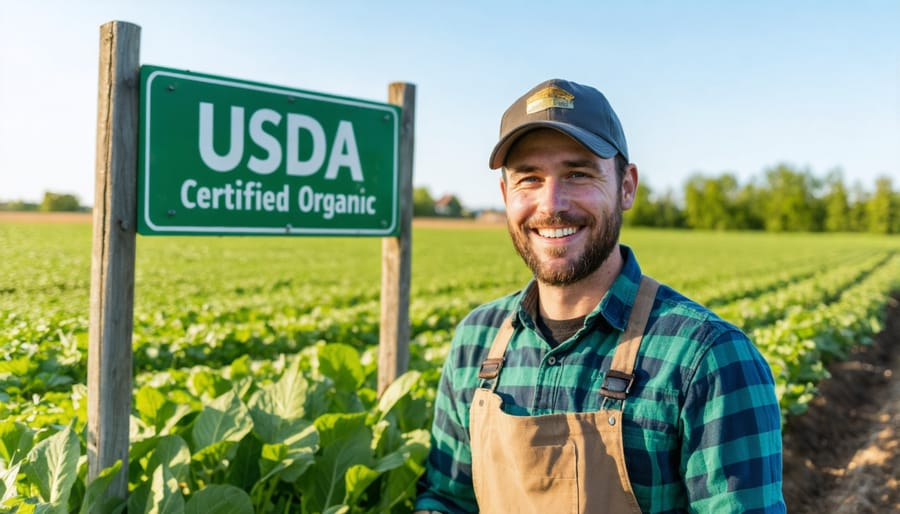
Alberta Success Stories
The journey to USDA organic certification may seem daunting, but several Alberta farmers have successfully navigated the process, demonstrating that it’s both achievable and rewarding. Among these success stories is the Sunshine Organic Farm in Parkland County, where Sarah and Mike Thompson transformed their 40-hectare family farm into a certified organic operation over three years.
“The key was maintaining detailed records from day one,” says Sarah Thompson. “We documented everything from seed sources to soil amendments, which made the certification process much smoother.” The Thompsons now supply organic vegetables to farmers’ markets throughout Edmonton and Calgary.
In Southern Alberta, Prairie Gold Organics, operated by the Martinez family, achieved certification in 2021. Their 65-hectare grain operation demonstrates how sustainable farming practices in Alberta can align with international certification standards. “We invested in soil health years before pursuing certification,” explains Carlos Martinez. “This gave us a strong foundation for meeting USDA requirements.”
Perhaps most inspiring is the story of New Horizon Farm near Red Deer, where first-generation farmers Jennifer and David Wong started with just 8 hectares in 2018. Within two years, they successfully certified their mixed vegetable and poultry operation. “We attended every workshop available and connected with mentor farmers who had gone through the process,” Jennifer shares. “The organic farming community in Alberta is incredibly supportive.”
These success stories share common threads: meticulous planning, thorough documentation, and a willingness to learn from others. All three farms emphasize the importance of building relationships with certifying agents early in the process and maintaining open communication throughout. They also highlight how certification has opened new market opportunities, particularly in cross-border trade with the United States.
Their experiences prove that while USDA organic certification requires dedication and patience, it’s an attainable goal for Alberta farmers committed to organic principles and willing to invest in the process.
Practical Steps to Get Started
Beginning your USDA organic certification journey requires careful planning and organization. Here’s a straightforward action plan to help you get started:
First, conduct a thorough assessment of your current farming practices. Document your existing soil management, pest control methods, and input usage. This baseline evaluation will help you identify gaps between your current operations and organic requirements.
Next, connect with your local organic certification body. In Alberta, several agencies are accredited to certify farms to USDA organic standards. Schedule an initial consultation to discuss your farm’s specific needs and timeline.
Create a detailed Organic System Plan (OSP). This comprehensive document outlines your production methods, including:
– Field histories for the past three years
– Seed sources and planting materials
– Soil fertility management strategies
– Pest and weed control methods
– Product handling and storage procedures
Begin your transition period. USDA organic certification requires a 36-month transition period during which no prohibited substances can be applied to your fields. Use this time to:
– Implement required record-keeping systems
– Train staff on organic practices
– Source approved inputs and materials
– Establish buffer zones if needed
Maintain detailed records from day one. Document everything, including:
– Input purchases and applications
– Planting and harvest dates
– Equipment cleaning logs
– Sales records
– Field activities
Consider joining local organic farming groups or attending workshops. Many experienced organic farmers in Alberta are willing to share their certification journey and practical advice. The organic farming community here is particularly supportive of new members.
Finally, schedule your first inspection. Prepare by organizing all your documentation and ensuring your operation fully complies with USDA organic standards. Remember, certification is an ongoing process, not a one-time event.
Get started with these steps today, and you’ll be well on your way to achieving USDA organic certification for your Alberta farm.
Pursuing USDA organic certification is a significant but rewarding journey for Canadian farmers. While the process requires careful planning and dedication, the benefits of accessing international markets and meeting growing consumer demand make it worthwhile. Start by thoroughly reviewing the National Organic Program standards and conducting a thorough assessment of your current farming practices. Consider connecting with local organic farming associations and mentors who have successfully navigated the certification process. Remember that transitioning to organic practices takes time, typically three years, but you can use this period to gradually implement changes and build strong documentation systems. The investment in certification can open doors to premium markets and sustainable farming practices that benefit both your operation and the environment. For personalized guidance, reach out to certification bodies operating in Alberta or contact your local agricultural extension office to begin your organic farming journey.

